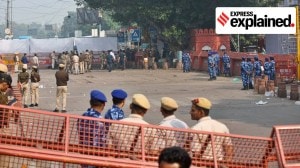RBI holds repo rate at 5.5 per cent, retains FY26 GDP growth at 6.5% despite tariff uncertainties
Inflation projection for current fiscal revised downward to 3.1% from 3.7%
 RBI Governor Sanjay Malhotra made the announcements on Wednesday. (File Photo: PTI)
RBI Governor Sanjay Malhotra made the announcements on Wednesday. (File Photo: PTI)In line with expectations, the Reserve Bank of India’s (RBI) Monetary Policy Committee (MPC) on Wednesday left the repo rate – the key policy rate – unchanged at 5.5 per cent.
Despite growing uncertainties related to US tariffs and geopolitical tensions, the RBI retained its real GDP growth projection for FY26 at 6.5 per cent, with Governor Sanjay Malhotra asserted the economy was performing “very well” and would “continue to further improve” when asked to respond to US President Donald Trump calling the Indian economy “dead”.
Meanwhile, the central bank sharply lowered its Consumer Price Index (CPI) inflation forecast for the current fiscal by 60 basis points (bps) to 3.1 per cent, compared to an earlier estimate of 3.7 per cent.
After cutting the repo rate by 100 bps over the last three consecutive monetary policies, the six-member MPC’s unanimous decision to keep the repo rate unchanged offers no additional relief to borrowers ahead of the upcoming festive season, as they will have to continue paying higher interest rates on their loans. However, Malhotra said the transmission of past rate cuts is “continuing”.
“The current macroeconomic conditions, outlook and uncertainties call for continuation of the policy repo rate of 5.5 per cent and wait for further transmission of the front-loaded rate cut to the credit markets and the broader economy. Accordingly, the MPC unanimously voted to keep the repo rate unchanged,” the RBI governor said while announcing the monetary policy. The rate-setting panel also decided to continue with the ‘neutral’ policy stance.
The MPC’s decision comes days after Donald Trump announced a 25 per cent tariff on Indian goods and a ‘penalty’ for importing energy items and arms from Russia. This week, the American President has threatened to further substantially hike the tariff on India even though the two countries continue to negotiate over a bilateral trade agreement.
Despite the global uncertainty, the RBI on Wednesday retained its annual and quarterly real GDP growth forecasts for 2025-26 at 6.5 per cent for April-June 2025, 6.7 per cent for July-September 2025, 6.6 per cent for October-December 2025, and 6.3 per cent for January-March 2026. In Q1 FY27, real GDP is expected to grow 6.6 per cent.
The governor said the above normal southwest monsoon, lower inflation, rising capacity utilisation, and congenial financial conditions continue to support domestic economic activity, with domestic growth evolving “broadly” along expected lines even though some high-frequency indicators showed mixed signals in May and June. The supportive monetary, regulatory, and fiscal policies including robust government capital expenditure should also boost demand, he added.
In the medium-term also, Malhotra said the prospects of the economy are “bright” amid a changing world order, aided by its inherent strength, robust fundamentals, and comfortable buffers. “Opportunities are there for the taking, and we are making all efforts to create enabling conditions through a multi-pronged yet cohesive approach to policy making,” he added.
However, he warned that while financial market volatility and geopolitical uncertainties have abated from their peaks in recent months, trade negotiation challenges continue to linger.
“Prospects of external demand, however, remain uncertain amidst ongoing tariff announcements and trade negotiations. The headwinds emanating from prolonged geopolitical tensions, persisting global uncertainties, and volatility in global financial markets pose risks to the growth outlook,” the governor said.
When asked to comment on Trump calling the Indian economy ‘dead’, Malhotra said the country had seen a very robust growth rate of 6.5 per cent, with the International Monetary Fund (IMF) projecting India’s GDP growth rate at 6.4 per cent for the current fiscal even as the global economy is expected to grow 3 per cent in 2025.
“We (India) are contributing about 18 per cent (to global growth), which is more than the US, where the contribution is expected to be much lesser, about 11 per cent. So, we are doing very well and we will continue to further improve,” Malhotra noted.
On inflation, Malhotra said the inflation outlook for 2025-26 had become more benign than expected in June. For the current financial year, the RBI has revised downwards its inflation forecast to 3.1 per cent from 3.7 per cent, with the quarterly CPI projections lowered as well. In Q2 FY26, inflation is projected at 2.1 per cent, compared to 3.4 per cent estimated in June, and at 3.1 per cent in Q3 FY26 as against 3.9 per cent earlier.
For January-March 2026, the inflation projection has been retained at 4.4 per cent. CPI inflation in Q1 FY27 is seen rising to 4.9 per cent, with Malhotra saying retail prices are seen increasing at a faster rate “as unfavourable base effects, and demand side factors from policy actions come into play”. Weather-related shocks pose risks to the inflation outlook, he added.
Asked if RBI was worried about inflationary pressures due to the US’ tariffs, the governor said no major impact was expected, as of now, with RBI Deputy Governor Poonam Gupta adding that nearly half of India’s inflation basket consists of food, which does not get impacted directly by global developments. Also, a significant part of the basket consists of non-tradable items, which again are not impacted by global developments such as tariffs.
“So, to that extent, a first-order direct impact of these evolving uncertainties on India’s inflation is likely to be very limited,” Gupta said.
Commenting on the policy, Madhavi Arora, Chief Economist at Emkay Global Financial Services, said the MPC’s decision to keep rates unchanged largely emanates from its assessment of forward-looking inflation, which appears to be inching well above 4 per cent, while in its view, growth has held up well despite global uncertainty.
“However, the RBI’s focus on one-year ahead expected inflation appears increasingly misplaced in an evolving world – particularly as the global landscape continues to shift toward a disinflationary bias in Asia,” she said.
The downside risks to growth would be increasingly evident with global resets and could open up space for easing in the rest of the year, even though the MPC seems to have raised the bar for further easing, Arora said.






- 01
- 02
- 03
- 04
- 05

























